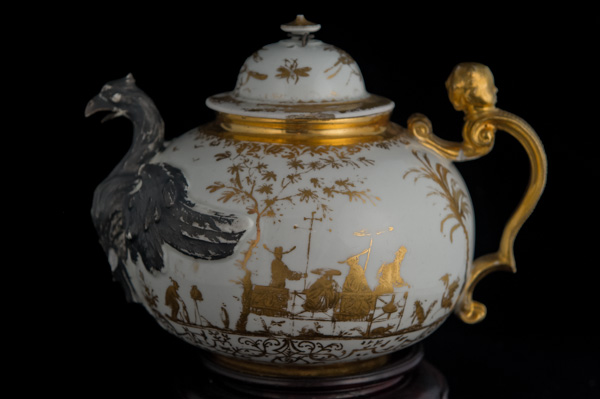Carol & Ryland Scott Porcelain Collection (for sale)
Part of the original collection by Cleo M. & George Ryland Scott

P069 - BÖTTGER TEAPOT AND A COVER
Circa 1710-1715, the gilding possibly Augsburg and of slightly later date
With Goldchinesen decoration, the scroll handle surmounted by a putto’s head, the silvered spout as an eagle
Lustre interlaced C’s decorator’s mark
(one of the eagle’s talons is chipped; the rim of the cover has some rim chips and is probably matched)
5 ¼ in. (13.3 cm) high 6 ¾ in. (17.1 cm) long overall
LITERATURE
Cleo M. and G. Ryland Scott Jr., Antique Porcelain Digest, Newport, England, 1961, p. 188, plate 42, fig. 169.
EXHIBITION
On display in the Scott-Allen Collection at The High Museum of Art, Atlanta, Georgia from 1976 until 1996
On display in the “George Ryland Scott Collection” at The Memphis Brooks Museum of Art between June 1955 and May 1960
NOTES BY CLEO M. AND G. RYLAND SCOTT, JR in the late 1950’s
POLISH EAGLE TEAPOT. (1710-1715)
Purchased while in England in 1950, from Hans Backer, 1 Elm Tree Road, St. John’s Wood, London N.W.8. He is one of the known English dealers in early Meissen Porcelain. He is a friend of Mr. Honey who refers to his collection in the new Honey book, "European Ceramic Art". See p. 53- plate XV.
He guaranteed the Tea Pot as follows; "Meissen large teapot of Bottger porcelain (about 1710-1715) after a model made in brown Bottger ware by Irminger, a child’s head on the handle, the Polish Eagle as spout, decorated with Gold Chinoiseries, in the workshop of the Seuter family in Augsburg about 1725-1735. Seuter luster mark
See "Schmidt, p. 62. Similar teapot in Red Stoneware, Fillman Collection, Hamburg. Honey Dresden China, p. 179 note 29 refers to the red stoneware example and also porcelain examples in Klemperer Collection No. 103, Fischer Cat. of 1918-No 136, Kakiemon decoration, Clemm No.79 and Osterman, No 71 with gold Chinese and “C” scrolls.
Some authorities disagree with Honey and think the gold was put on at the factory. See Hanover, p. 51 "On the other hand, the progress made by Bottger in the firing on upon his porcelain of gold and silver is remarkable, considering that the same was never a success with his stoneware. His silver has, of course long since turned black through oxidation, but the gold has as a rule withstood the action of time."
Honey Dresden Porcelain, p. 46- verifies the use of silver during the Bottger period. The eagle on our teapot has also turned black. It will be remembered that August the Strong in addition to being Elector of Saxony, was King of Poland, whose coat of arms included the "Eagle".
See also Cox p. 646, who says Bottger was successful in applying gold and silver. Ralph Wark advances many good reasons why some of the gold work was factory other Hausmaler. Honey on the other hand attributes the Gold Chinoiseries exclusively/ to the Hausmaler.
Webmaster - Ryland Scott
© 2013, Ryland Scott